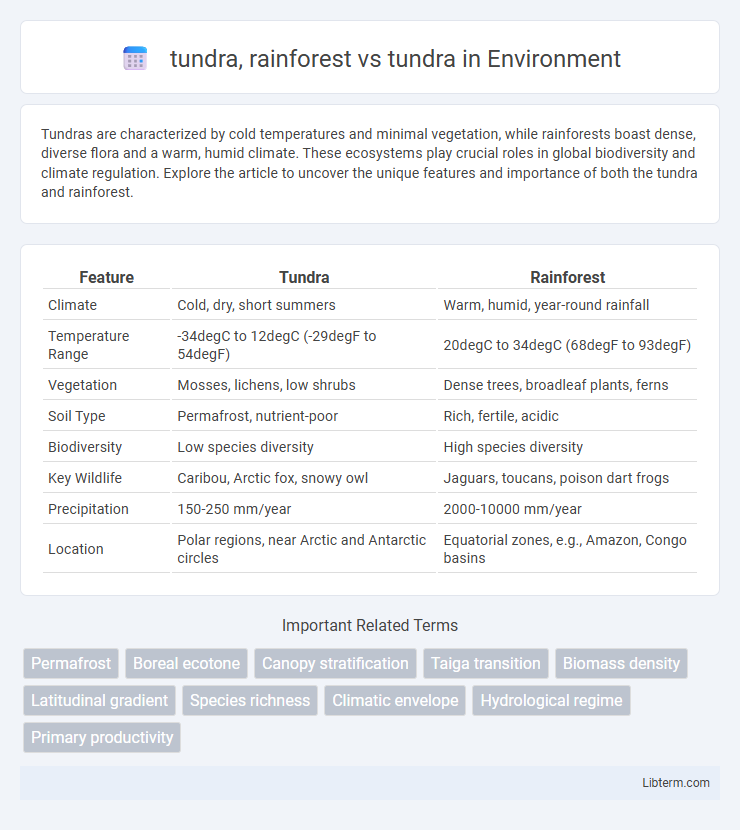Tundras are characterized by cold temperatures and minimal vegetation, while rainforests boast dense, diverse flora and a warm, humid climate. These ecosystems play crucial roles in global biodiversity and climate regulation. Explore the article to uncover the unique features and importance of both the tundra and rainforest.
Table of Comparison
| Feature | Tundra | Rainforest |
|---|---|---|
| Climate | Cold, dry, short summers | Warm, humid, year-round rainfall |
| Temperature Range | -34degC to 12degC (-29degF to 54degF) | 20degC to 34degC (68degF to 93degF) |
| Vegetation | Mosses, lichens, low shrubs | Dense trees, broadleaf plants, ferns |
| Soil Type | Permafrost, nutrient-poor | Rich, fertile, acidic |
| Biodiversity | Low species diversity | High species diversity |
| Key Wildlife | Caribou, Arctic fox, snowy owl | Jaguars, toucans, poison dart frogs |
| Precipitation | 150-250 mm/year | 2000-10000 mm/year |
| Location | Polar regions, near Arctic and Antarctic circles | Equatorial zones, e.g., Amazon, Congo basins |
Introduction to Tundra and Rainforest Ecosystems
Tundra and rainforest ecosystems represent two extremes in global biodiversity and climate conditions, with tundras characterized by cold temperatures, permafrost, and limited vegetation dominated by mosses, lichens, and low shrubs. Rainforests exhibit high biodiversity, warm and humid climates, and dense vegetation layers including towering trees, shrubs, and a rich variety of flora and fauna. Understanding these ecosystems highlights critical differences in soil composition, species adaptation, and ecological functions that drive global environmental processes.
Geographic Distribution of Tundra and Rainforests
Tundras primarily occur in high-latitude regions such as the Arctic Circle, covering parts of Alaska, Canada, Russia, and Scandinavia, characterized by cold temperatures and permafrost. Rainforests are predominantly found near the equator across continents including the Amazon Basin in South America, the Congo Basin in Africa, and Southeast Asia, featuring warm climates and high annual rainfall. The geographical distribution differences stem from climatic conditions, with tundras thriving in cold, dry environments and rainforests in warm, humid zones.
Climate Comparison: Tundra vs Rainforest
The tundra climate is characterized by extremely cold temperatures, low precipitation, and a short growing season, with average temperatures often below freezing and annual precipitation ranging between 150-250 mm mostly as snow. In contrast, rainforest climates are warm and humid year-round, receiving over 2000 mm of rainfall annually, which supports dense, biodiverse vegetation. The stark differences in temperature stability and moisture availability dictate the unique ecosystems found in tundra and rainforest regions.
Biodiversity in Tundra and Rainforest Regions
Tundra regions exhibit low biodiversity with specialized flora such as mosses, lichens, and hardy shrubs adapted to cold, nutrient-poor soils, while fauna includes species like caribou, arctic foxes, and migratory birds. Rainforests showcase unparalleled biodiversity, housing over half of the world's terrestrial species, with dense vegetation layers supporting diverse mammals, insects, amphibians, and birds. The contrast in biodiversity between tundra and rainforest ecosystems is primarily driven by temperature, precipitation, and habitat complexity, influencing species richness and ecological interactions.
Soil Characteristics: Differences and Impacts
Tundra soils are typically shallow, acidic, and nutrient-poor, often underlain by permafrost that restricts drainage and root penetration, leading to limited plant growth. In contrast, rainforest soils, though warm and moist, are often nutrient-poor due to heavy rainfall leaching essential minerals, but their rapid organic matter decomposition supports rich biodiversity. These distinct soil characteristics heavily influence vegetation types, carbon storage capacity, and ecosystem productivity in both biomes.
Flora Adaptations in Tundra and Rainforest
Flora adaptations in the tundra include low-growing plants like mosses and lichens that withstand extreme cold, permafrost, and short growing seasons by minimizing exposure and conserving heat. In contrast, rainforest plants exhibit adaptations such as broad leaves with drip tips to shed excess water, deep root systems, and rapid growth to compete in nutrient-rich, humid environments. These contrasting adaptations highlight how tundra vegetation survives harsh, frozen conditions, while rainforest flora thrives in warm, moisture-abundant ecosystems.
Fauna Diversity and Survival Strategies
Tundra ecosystems support low fauna diversity, consisting mainly of hardy species like caribou, Arctic foxes, and migratory birds adapted to extreme cold and limited vegetation. Rainforests exhibit high fauna diversity with myriad insect, amphibian, bird, and mammal species thriving in warm, humid conditions and dense vegetation. Survival strategies in tundras include seasonal migration, hibernation, and physiological adaptations to conserve heat, whereas rainforest animals rely on camouflage, arboreal lifestyles, and complex food webs to sustain their populations.
Human Influence on Tundra and Rainforests
Human influence on tundra and rainforests significantly alters these ecosystems' biodiversity and carbon storage capacities. In tundra regions, industrial activities like mining and oil extraction disrupt permafrost and fragile vegetation, leading to increased greenhouse gas emissions. Rainforests face deforestation due to logging, agriculture, and urban expansion, resulting in habitat loss and decreased climate regulation services.
Ecological Importance and Environmental Roles
Tundras serve as crucial carbon sinks, storing vast amounts of organic carbon in their permafrost soils and supporting specialized flora and fauna adapted to extreme cold. Rainforests, in contrast, are biodiversity hotspots with complex ecosystems that regulate global climate by absorbing significant greenhouse gases and maintaining hydrological cycles through transpiration. Both ecosystems play vital roles in sustaining global ecological balance, with tundras stabilizing carbon release and rainforests driving oxygen production and climate moderation.
Conservation Challenges in Tundra and Rainforest Ecosystems
Tundra ecosystems face conservation challenges such as permafrost thawing, habitat loss for cold-adapted species, and vulnerability to invasive species, driven largely by climate change. Rainforest ecosystems struggle with deforestation, biodiversity loss, and soil degradation caused by logging, agriculture, and mining activities. Both biomes require targeted conservation strategies to address their distinct threats and preserve their ecological integrity.
tundra, rainforest Infographic

 libterm.com
libterm.com